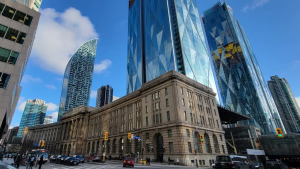Building Benchmark BC, a pilot project to collect data on building performance, has released its first annual report.
Organizers hope as the number of buildings and participants involved in the project grows, the data gleaned will be useful for crafting policy and directing capital in the fight against greenhouse gas emissions.
“The first caution is that this is a pilot and the data conclusions are built on relatively small sample sizes,” explained Donovan Woollard, the managing director of the OPEN Green Building Society, which is hosting the project. “Once this becomes more universal, will all those trends hold up? Possibly. Over time we will have more and more data that is usable for directing policy and capital.”
Building benchmarking is the process of collecting and monitoring energy and greenhouse gas data from a large number of buildings over time, allowing owners, managers, occupants and governments to compare the performance of similar properties.
Submitted properties to date for the project represent over 4.96 million square metres of conditioned floor space and more than 700 individual properties. The project also saw 12 jurisdictions participate, including the City of Vancouver which eventually plans to make building benchmarking mandatory.
So far, the project team has received data on 70 per cent of the properties due to disruption from the COVID-19 pandemic on building owners, managers and jurisdictions.
Woollard noted so far the data shows that determining a building’s environmental impact is not as simple as measuring its energy use.
The report noted that swimming pools and convention centres have the highest energy use intensity (EUI) per square metre. However, convention centres often use electricity for heating, which in British Columbia is more than 94 per cent non-emitting. Meanwhile, pools are heated with natural gas, a leading source of climate pollution.
“While both use a lot of energy, only one also produces a lot of carbon,” states the report. “And neither burns as much natural gas as a share of their total energy consumption as education facilities, gyms, or fire stations.”
The data also shows that buildings built in the 1970s, on average, consume far more energy for heating and cooling than those built in other decades. The report explained this is likely a reflection of the building materials and approaches in use at the time. Many are concrete buildings with glass curtain walls and single glazing. In addition, the envelopes of many of these buildings are reaching the end of their useful life.
Woollard said the program is already on track to meet its year two goal of benchmarking 2,000 buildings. The program developed digital tools with the financial support of Natural Resources Canada so participants can input data and, if they wish, share it with the public.
“There is no cost to participate and we provide some support material to input data,” said Woollard. “What they get is benchmarking comparison data against peers and insights on what might be contributing to their performance level. Vancouver and others are looking at how they can work with industry to address climate change and this is an opportunity to be ahead of the curve.”
The online tool that can be used to interact with the data is available here: buildingbenchmarkbc.ca/data
Follow the author on Twitter @RussellReports.





Recent Comments
comments for this post are closed